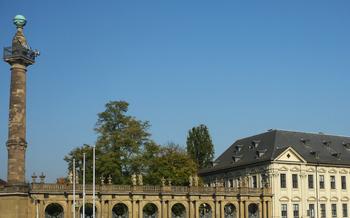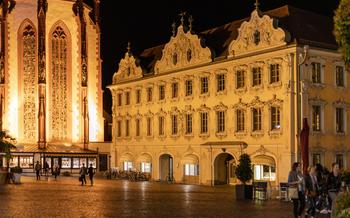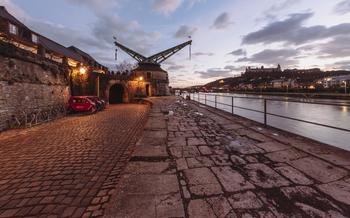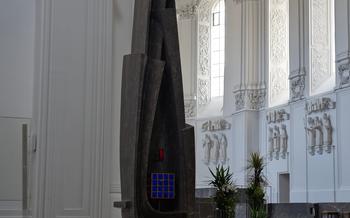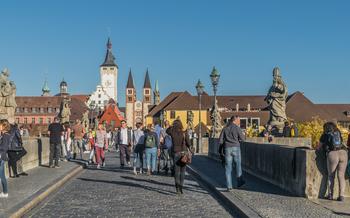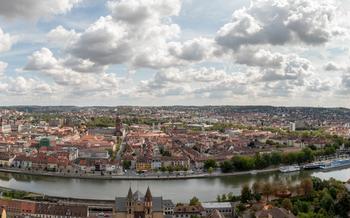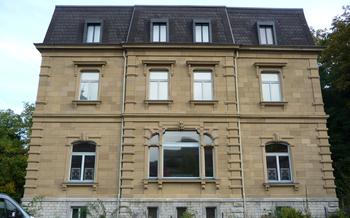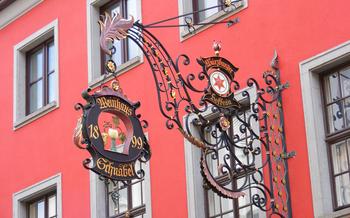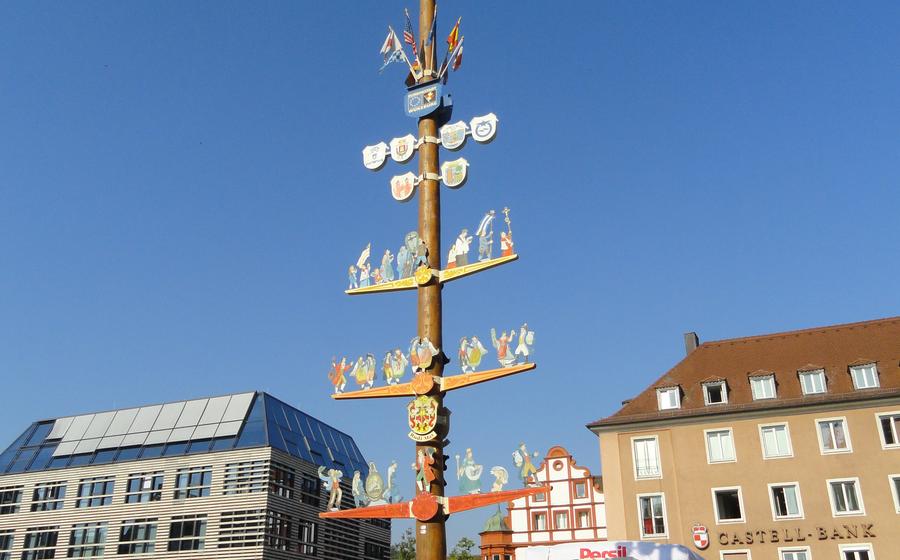
Market Square
- Würzburg's Market Square
- Marienkapelle
- Altes Rathaus
- Schönbornkapelle
- Käppele
- Würzburg Cathedral
- Hofgarten
- Alte Mainbrücke
- Juliusspital
- Mainfränkisches Museum
- Siebold-Museum
- Franken Center
- Insider Tip
Würzburg's Market Square
Würzburg's Market Square, the heart of the city's Old Town, is a vibrant and historic space that has been a center of commerce and community gatherings for centuries. The square is surrounded by a diverse mix of architectural styles, from the Gothic Marienkapelle to the Renaissance Altes Rathaus, each contributing to its unique charm. In the center of the square stands a large fountain, the Marktbrunnen, which has become an iconic symbol of Würzburg. With its lively atmosphere, bustling markets, and must-visit attractions, Würzburg's Market Square is a must-see destination for any visitor to the city.
Marienkapelle
The Marienkapelle (St. Mary's Chapel) is a stunning example of Gothic architecture in Würzburg. Built in the 14th century, the chapel is dedicated to the Virgin Mary and is a symbol of Würzburg's devotion to her. The chapel's exterior is adorned with intricate carvings, while the interior features stunning stained glass windows and a beautiful altar. One of the most striking features of the Marienkapelle is its single spire, which rises high above the city and can be seen from miles around. The chapel is a popular tourist destination and a must-see for anyone interested in Gothic architecture or religious history.
Intricate Carvings The Marienkapelle is renowned for its exquisite carvings, which adorn the exterior and interior of the chapel. The most notable carvings are the gargoyles, which are grotesque figures that are said to ward off evil spirits. The gargoyles are carved with great detail and are a testament to the skill of the medieval craftsmen who created them.
Stunning Stained Glass Windows The Marienkapelle's stained glass windows are another highlight of the chapel. The windows were created in the 14th and 15th centuries and depict scenes from the life of the Virgin Mary and other biblical stories. The windows are a beautiful example of the art of stained glass and fill the chapel with a warm and colorful light.
Symbol of Würzburg's Devotion to the Virgin Mary The Marienkapelle is a symbol of Würzburg's devotion to the Virgin Mary. The chapel was built at a time when the city was suffering from the Black Death, and the people of Würzburg prayed to the Virgin Mary for protection. The chapel was completed in 1377, and the Black Death soon after disappeared from the city. The Marienkapelle is a reminder of the power of faith and the importance of the Virgin Mary to the people of Würzburg.
Altes Rathaus
The Altes Rathaus, or Old Town Hall, is a splendid edifice that stands as a testament to Würzburg's rich architectural heritage. This Renaissance masterpiece, constructed between 1571 and 1575, boasts an elaborate facade adorned with intricate carvings, sculptures, and a striking clock tower. The Rathaus once served as the city's administrative center and is now home to the City Museum, which houses an impressive collection of artifacts and exhibits that narrate Würzburg's fascinating history from its humble beginnings to its emergence as a significant cultural and religious hub.
Schönbornkapelle
The Schönbornkapelle is a Baroque masterpiece located in the heart of Würzburg's Market Square. Built in the 17th century by the Schönborn family, former rulers of Würzburg, the chapel is a testament to their wealth and power. The lavish interior features intricate carvings, opulent frescoes, and a stunning altar. The chapel is also home to the tomb of Johann Philipp von Schönborn, the prince-bishop who commissioned its construction.
The Schönbornkapelle is a must-see for any visitor to Würzburg. Its elaborate architecture and rich history make it one of the most impressive buildings in the city. Visitors can admire the intricate carvings on the facade, which depict scenes from the life of the Virgin Mary. The interior of the chapel is equally impressive, with its high ceilings, marble columns, and gold-leaf decorations. The altar is a masterpiece of Baroque art, with its intricate carvings and vibrant colors.
The Schönbornkapelle is a reminder of the opulence and power of the Schönborn family. It is also a testament to the skill and artistry of the Baroque craftsmen who built it. The chapel is a valuable part of Würzburg's cultural heritage and is sure to impress visitors with its beauty and grandeur.
Käppele
Perched majestically atop a hill, the Käppele, a breathtaking Rococo pilgrimage church, commands awe-inspiring views of Würzburg and its picturesque surroundings. This architectural masterpiece, designed by Balthasar Neumann, is an embodiment of the Rococo style, characterized by its intricate detailing, soft pastel hues, and graceful curves.
The interior of the Käppele is as captivating as its exterior. The walls and ceiling are adorned with exquisite frescoes and stucco work, depicting scenes from the life of the Virgin Mary. The high altar, a focal point of the church, is a testament to the artistry of the Rococo period, with its intricate carvings and radiant gold leaf.
The Käppele is a testament to the deep devotion of the people of Würzburg to the Virgin Mary. It has been a popular pilgrimage site for centuries, and continues to draw visitors from all over the world. Whether you are a pilgrim seeking spiritual solace or simply an admirer of architectural beauty, the Käppele is a destination that will leave an unforgettable impression.
Würzburg Cathedral
Würzburg Cathedral, an architectural masterpiece that seamlessly blends Romanesque and Gothic elements, stands as the fourth-largest Romanesque cathedral in Germany. Its awe-inspiring presence dominates the city's skyline, beckoning visitors with its rich history and sacred significance. Step inside to marvel at the intricate carvings that adorn the sandstone walls, each one a testament to the skill and devotion of medieval artisans. The stunning stained glass windows bathe the interior in a kaleidoscope of colors, creating an ethereal atmosphere that invites contemplation and reverence. As you wander through the cathedral, pay homage to St. Kilian, Würzburg's patron saint, whose tomb lies within these hallowed walls. This magnificent cathedral is not just a symbol of Würzburg's deep-rooted faith, but also a testament to the enduring power of human artistry and devotion. For any visitor to this vibrant city, Würzburg Cathedral is an absolute must-see, a place where history, art, and spirituality converge in a breathtaking symphony of architectural grandeur.
Hofgarten
The Hofgarten is a stunning Baroque garden that ad it was conceived as an extension of the palace's grand design. The garden is characterized by its symmetrical layout, manicured lawns, and ornate fountains.
Stroll along the garden's central axis, which is anchored by a series of cascading fountains and framed by towering hedges. Admire the intricate patterns and topiaries that adorn the garden, creating a sense of harmony and balance. Take a moment to relax by the Venusbrunnen, a beautiful fountain featuring a statue of the goddess Venus.
The Hofgarten is not just a visual feast but also a haven for nature lovers. Explore the garden's diverse collection of plants, including colorful flower beds, fragrant rose gardens, and towering trees. Enjoy the tranquil atmosphere as you wander through the garden's many paths, immersing yourself in the beauty of nature.
Whether you're seeking a peaceful retreat or a picturesque backdrop for your photos, the Hofgarten is a must-visit destination in Würzburg. Its combination of Baroque splendor and natural beauty makes it a truly enchanting place to explore.
Alte Mainbrücke
Crossing the Main River with elegance and historical significance, the Alte Mainbrücke, or Old Main Bridge, serves as a vital connection between Würzburg's vibrant Old Town and the tranquil New Town. Constructed in the 15th century and adorned with exquisite statues of saints and mythological figures, this bridge has stood as a testament to the city's rich cultural heritage for over 500 years.
A stroll across the Alte Mainbrücke is a journey through time, where history and modernity harmoniously intertwine. As you traverse its cobblestone path, take a moment to admire the intricate details of the bridge's sandstone sculptures, each one narrating a unique tale from Würzburg's past. The bridge's central arch, gracefully spanning the river, offers breathtaking views of the city's iconic landmarks, including the majestic Würzburg Cathedral and the sprawling Residenz palace.
Whether you're a seasoned traveler or a local resident, crossing the Alte Mainbrücke is an experience not to be missed. It's a place where the essence of Würzburg's history and culture can be deeply felt, making it a must-visit attraction for anyone exploring this charming city.
Juliusspital
The Juliusspital is a former hospital founded in 1576 by Fürstbischof Julius Echter von Mespelbrunn. It is one of the largest hospitals in Germany and has been in continuous operation for over 400 years. The hospital was originally intended to provide care for the poor and sick of Würzburg, but it has since expanded to offer a wide range of medical services.
In addition to its medical services, the Juliusspital is also home to a winery and a restaurant. The winery produces a variety of wines, including red, white, and sparkling wines. The restaurant serves traditional Franconian cuisine, as well as international dishes.
The Juliusspital is a popular destination for both locals and tourists. Visitors can tour the hospital, visit the winery, or enjoy a meal at the restaurant. The hospital also offers a variety of events throughout the year, including wine tastings, concerts, and art exhibitions.
Here are some tips for visiting the Juliusspital:
- Take a tour of the hospital. Tours are available in English and German.
- Visit the winery. The winery offers a variety of wine tastings, and visitors can also purchase wine to take home.
- Have a meal at the restaurant. The restaurant serves traditional Franconian cuisine, as well as international dishes.
- Attend an event. The Juliusspital offers a variety of events throughout the year, including wine tastings, concerts, and art exhibitions.
- Visit the gift shop. The gift shop sells a variety of souvenirs, including wine, cheese, and other Franconian products.
Mainfränkisches Museum
Mainfränkisches Museum is a regional history museum located in the heart of Würzburg, Germany. The museum is housed in the former Mainfränkische Volksbank building, a striking example of Art Nouveau architecture. The museum's collection spans over 100,000 objects, including artifacts, documents, and works of art that tell the story of the history and culture of Franconia, the region in which Würzburg is located.
The museum's exhibits are divided into four main sections: prehistory and early history, the Middle Ages, the early modern period, and the modern period. The prehistory and early history section features exhibits on the region's earliest inhabitants, the Celts, and the Romans. The Middle Ages section focuses on the rise of Christianity in the region, the development of the city of Würzburg, and the role of the region in the Holy Roman Empire. The early modern period section covers the Renaissance, the Reformation, and the Thirty Years' War. The modern period section explores the region's industrialization, its role in the two World Wars, and its postwar reconstruction.
Mainfränkisches Museum is a must-visit for anyone interested in learning more about the history and culture of Franconia. The museum's exhibits are well-curated and informative, and the museum's staff is friendly and helpful. The museum is also located in a beautiful building, and its courtyard is a great place to relax and enjoy the outdoors.
Siebold-Museum
The Siebold-Museum is an ethnological museum located in the former Siebold House in Würzburg, Germany. It is dedicated to the life and work of Philipp Franz von Siebold, a German physician and naturalist who lived in Japan in the 19th century. The museum houses a collection of artifacts and documents related to Siebold's time in Japan, as well as exhibits on Japanese culture and history.
Siebold was born in Würzburg in 179He studied medicine at the University of Würzburg and later worked as a physician in the Dutch East Indies. In 1823, he was appointed as the physician to the Dutch trading post in Nagasaki, Japan. Siebold spent seven years in Japan, during which time he collected a vast amount of information about the country's culture, history, and natural history. He was also instrumental in introducing Western medicine to Japan.
After returning to Germany, Siebold published several books and articles about his experiences in Japan. He also donated his collection of artifacts and documents to the University of Würzburg. The Siebold-Museum was founded in 1927 to house this collection and to promote research on Japanese culture and history.
The museum's collection includes over 10,000 objects, including books, manuscripts, paintings, prints, photographs, maps, and artifacts. The exhibits cover a wide range of topics, including Japanese art, history, religion, and society. The museum also has a library with over 20,000 volumes on Japan-related topics.
The Siebold-Museum is a valuable resource for scholars and students of Japanese culture and history. It is also a popular destination for tourists who are interested in learning more about Japan.
Franken Center
For those looking for a more modern shopping experience, the Franken Center is a must-visit. This state-of-the-art shopping mall is located in the heart of Würzburg's Old Town and features over 100 shops, restaurants, and cafes. Whether you're looking for the latest fashion trends, a unique souvenir, or a delicious meal, you're sure to find it at the Franken Center.
The mall is also home to a cinema, a bowling alley, and a fitness center, making it a great place to spend a day of shopping, dining, and entertainment. And with its convenient location, it's easy to get to from anywhere in the city.
So if you're looking for a place to shop, dine, and be entertained, the Franken Center is the perfect place for you.
Insider Tip
If you're planning a trip to Würzburg, here are a few insider tips to make the most of your visit:
-
Best time to visit: The best time to visit Würzburg is during the summer months, when the weather is warm and sunny. The city comes alive with outdoor activities, festivals, and events.
-
Local wine: Be sure to try the local wine, which is known for its high quality. Würzburg is located in the Franconia wine region, which is one of the most important wine regions in Germany. There are many wine bars and restaurants in the city where you can sample the local wines.
-
Walking and biking: Würzburg is a great city for walking and biking. There are many bike paths that wind through the city and the surrounding countryside. You can rent bikes from several locations in the city.
-
Boat tour: Take a boat tour on the Main River to see the city from a different perspective. There are several boat tour companies that offer tours of the river, ranging from short sightseeing tours to longer cruises.
-
Old Town: Explore the Old Town, which is home to many of Würzburg's most popular attractions, including the Market Square, the Würzburg Cathedral, and the Residenz. The Old Town is also a great place to find shops, restaurants, and cafes.
